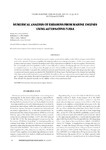Numerical Analysis of Emissions from Marine Engines Using Alternative Fuels

Use este enlace para citar
http://hdl.handle.net/2183/34907
A non ser que se indique outra cousa, a licenza do ítem descríbese como Creative Commons Attribution-NonCommercial-NoDerivatives 4.0
Coleccións
- Investigación (EPEF) [592]
Metadatos
Mostrar o rexistro completo do ítemTítulo
Numerical Analysis of Emissions from Marine Engines Using Alternative FuelsData
2015-12-30Cita bibliográfica
M. I. Lamas et al, "Numerical Analysis of Emissions from Marine Engines Using Alternative Fuels," Polish Maritime Research, vol. 22, (4), pp. 48, 2015. DOI: 10.1515/pomr-2015-0070
Resumo
[Abstract]: The current restrictions on emissions from marine engines, particularly sulphur oxides (SOx ), nitrogen oxides (NOx ) and carbon dioxide (CO2 ), are compelling the shipping industry to a change of tendency. In the recent years, many primary and secondary reduction techniques have been proposed and employed in marine engines. Nevertheless,
the increasingly restrictive legislation makes it very difficult to continue developing efficient reduction procedures at competitive prices. According to this, the paper presents the possibility to employ alternative fuels. A numerical model was developed to analyze the combustion process and emissions using oil fuel, natural gas and hydrogen.
A commercial marine engine was studied, the Wärtsilä 6L 46. It was found, that hydrogen is the cleanest fuel regarding CO2 , hydrocarbons (HC) and carbon monoxide (CO). Nevertheless, it is very expensive for marine applications. Natural gas is cheaper and cleaner than fuel oil regarding CO2 and CO emissions. Still, natural gas emits more NOx and HC than oil fuel. SOx depends basically on the sulphur content of each particular fuel.
Palabras chave
Fuel
Natural gas
Hydrogen
Marine engine
Emissions
Natural gas
Hydrogen
Marine engine
Emissions
Versión do editor
Dereitos
Creative Commons Attribution-NonCommercial-NoDerivatives 4.0
ISSN
2083-7429






